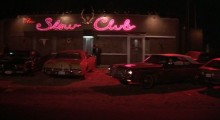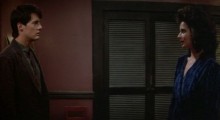Columns
-
Jess + Moss — A Hammer to Nail Review
(Jess + Moss world premiered at the 2011 Sundance Film Festival. It opens theatrically at the reRun Gastropub in New York City on Friday, February 17, 2012. If you are not in NYC, don’t worry, as it is now available on VOD at the following outlets: YouTube, iTunes, Sundance Now, and Amazon. Visit the film’s official website to learn more.) While there are many pressing existential questions, to my mind, this is one of the most significant: can one make a truly effective film about aimlessness and boredom without that film becoming excruciatingly aimless and boring in its own right? […]
-
The Micro-Budget Conversation: Is Enough… Enough ?
When and how did Edward Burns become the mouthpiece of micro budget cinema? That’s a question I asked on Facebook after a late night holiday bender and noticing the ridiculous amount of press Ed got for making a film that certainly didn’t cost him 9K. Then I thought, who really does make a film for 9K? If you add up all the favors and salaries that are not getting paid you’re in the hundreds of thousands. Then I thought, oh man is there any such thing as micro-budget at all? Or is it like the myth of cover girl beauty. […]
-
The Blue Velvet Project, #80

Second #3760, 62:40 Jeffrey, having arrived later than expected to pick up Sandy after school, has just been spotted by Sandy’s boyfriend Mike, who is doing a variation of jumping jack exercises with the football team (in full uniform, including helmets) on a tennis court across the street in a scene that oddly predicts the “Do the Locomotion” scene in Inland Empire. We are back in the sunlight now, the deeply coded normalcy of high school, the girls in their long skirts recalling the teenage rebel movies of the 1950s. The frame captures no one looking at anyone. Dead gazes. […]
-
The Blue Velvet Project, #79

Second #3713, 61:53 Jeffrey, having followed Frank to a building, sneaks inside at night to confirm that it is, indeed, where Frank lives. The shot only lasts a few seconds, and serves as a bridge between what has just come before (Jeffrey’s cloaked, nighttime pursuit of Frank) and what will come after (the scene at Arlene’s Diner with Sandy as he recalls to her witnessing the actions of the Yellow Man, the Well-Dressed Man, and Frank). The frame is pure Expressionism as Jeffrey finds himself searching for Frank’s name on the mailboxes in a low-angle shot whose shadows and lines […]
-
The Blue Velvet Project, #78

Second #3666, 61:06 After Frank and his gang leave the Slow Club, Jeffrey follows them. He is a detective, now. The scene is bathed in hellish red. The slow rumble of thunder ratchets up the tension. There is no one for Jeffrey, neither Dorothy nor Sandy. Not now, in the silence of his car. In fact, the movie has carried itself forward without functional dialogue for a while; it’s become pure cinema, where the images and sounds render dialogue obsolete, because of what use is dialogue in the bloodlands? In 2666, by Roberto Bolaño, a character, Norton, repeated, in German, […]
-
The Dish & The Spoon — A Hammer to Nail Review
(The Dish & The Spoon world premiered at the 2011 SXSW Film Festival. It opens theatrically at the reRun Gastropub in NYC on Friday, February 10, 2012. Visit the film’s official Facebook page to learn more.) Alison Bagnall’s The Dish & The Spoon opens with a distraught young woman named Rose (played by Greta Gerwig) hastily driving an old, large Mercedes station wagon into the rainy sprawl of an off-season Delaware beach town. When her cell phone rings, she only hesitates for a moment before throwing it out the window onto the highway. This act — equal parts defiant, hostile, […]
-
The Blue Velvet Project, #77

Second #3619, 60:19 See shot 9 from the previous post (#76). Frank, here, is someone caught between the hipsterism of the 1940s and the 1990s, his Pabst Blue Ribbon signifying the working man’s authenticity as opposed to the soft, foreign Heineken, the baby-faced college boy’s beer. And yet Frank aspires to suaveness in his soft nightclub shirt and beer poured into a glass, not drunk out of a bottle. Frank is a slave to a fixed idea. When he watches Dorothy on the stage, what does he really see? What if there’s something in Dorothy that’s only available to him, […]
-
The Blue Velvet Project, #76

Second #3572, 59:32 Back at the Slow Club, Jeffrey has just poured himself a Heineken, and Dorothy has noticed something that has caused a shadow of fear to cross her face. In a subtle relay of looks captured in nine shots that last just over one minute, this happens: Shot 1: Jeffrey, having poured a Heineken, watches Dorothy perform “Blue Velvet.” Shot 2: (second #3572, the frame above) Dorothy sees something in the audience that spooks her. Shot 3: Jeffrey notices Dorothy’s fear, and turns his head to where she is looking. Shot 4: We see Frank, the object of […]
-
The Blue Velvet Project, #75

Second #3525, #58:45 A classic two-shot, Jeffrey and Dorothy looking at each other across the open space of the screen. Dorothy is framed within the frame by the impossible closet (a sort of black screen) in the background. No longer dressed in black, Jeffrey’s character begins to separate itself from the hinted-at idea that he is somehow another, younger version of Frank. Although Blue Velvet is not alone in taking viewers into a sealed-off fictive world, it does so, strangely, by referring to the outside, “real” world (our world) not directly, but indirectly, through archetypes. There is a detective, a […]
-
Bad Fever — A Hammer to Nail Review
(Bad Fever opens in New York City at the reRun Gastropub beginning Friday, January 3, 2011. It world premiered at the 2011 SXSW Film Festival and is being distributed by Factory 25. Visit the film’s official website to learn more.) For those viewers with a deep-seated fondness for the character-based New Hollywood dramas that were churned out in the 1970s, Dustin Guy Defa’s Bad Fever will feel like a welcome return to that glorious past (I should know, as I am guilty of said deep-seated fondness). From the spare opening title card—complete with a copyright tag at the bottom!—to its […]
